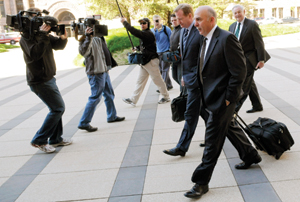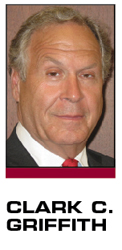I keep hearing that fans don’t care about the NFL squabble, as they see it as about money and all they want are games. Everyone wants games, the NFL and its players want games, but this issue is about more than mere money, as it is about who controls the NFL. This will be determined by whether the league/player relationship is controlled by labor or antitrust law.
The difference between the two laws is distinct. Labor law allows combinations that restrain competition in the player labor market, for example, and antitrust law makes those restraints, if found to be unreasonable at trial, illegal. Antitrust also allows tripling of damages, so if found to owe the players $1 billion, the NFL will be compelled to pay $3 billion. If you think the parties are being tough-minded about this dispute, that is what they are playing for.
This is not the first time the players have used antitrust to attack the league. In the earliest days of the union, Ed Glennon, a Minneapolis lawyer, conceived of a plan to use antitrust to attack the Rozelle Rule, which gave the commissioner the right to set compensation for free agent players lost. U.S. District Judge Earl Larson ruled that the Rozelle Rule was per se illegal, or illegal without redeeming virtue of any sort. From that victory, the players have filed most of their cases in Minnesota, where Judge David Doty has presided over disputes for twenty years. He is currently presiding over the TV fees case.
The case at hand, naming Tom Brady and others as plaintiffs, was also filed in Minnesota. Judge Susan Richard Nelson enjoined the NFL’s effort to lock out players. The case, however, has some very curious twists. First is that the owners locked out the players by using a labor law weapon and the players sought an injunction claiming it was a violation of antitrust law. Antitrust cannot be used in labor, so the players had to decertify as a union to file the suit. This is a very complicated matter and it is being considered by the 8th U.S. Circuit Court of Appeals, which has issued a stay of the injunction, putting the lockout back in place after three days. It will rule on the legality of the injunction soon.
 |
GETTY IMAGES
Commissioner Roger Goodell and the NFL’s lawyers used a labor statute to lock out players. |
In stopping the lockout, Nelson paid a lot of attention to the players’ claim that they would suffer irreparable harm if she didn’t. “Irreparable” in this context means that no amount of money can compensate an injured party. Sports, however, is a business that has inherent balance. Where one player is harmed and loses a job, another earns a job. A harmed player can certainly claim that the harm caused them to suffer monetary damage. Suing management has never been a problem before.
There is also the legal issue of whether the court could enjoin a legal lockout. Several statutes suggest that it doesn’t have that power, as federal labor policy encourages an evenness in negotiations that allow both sides to use economic power to bring about a deal. Players can strike; management can lock out. To keep this structure in place, courts have very limited roles in labor negotiations. Courts are used in unfair-labor-practices cases like the one that ended the baseball deadlock in 1995, can enjoin strikes and lockouts in national emergencies, and can rule on violations of labor contracts. There should be no injunction here.
This federal policy favoring non-intervention of the courts is found in the doctrine of primary jurisdiction. This means that Congress has decided that labor law is so important that primary jurisdiction is in the National Labor Relations Board and not in courts. Labor law experts are to be judges here, not federal trial court judges with little labor experience.
The hearing at the Court of Appeals that will decide this matter is scheduled for Friday. The winner at the 8th Circuit will have a real advantage.
Conventional wisdom teaches that the ultimate goal is a collective-bargaining agreement, with the players again certifying as a union. However, this time things may be different. The concept that labor law gives management too much power so that the players should try antitrust has been circulating in the sports law world for years. In this case, it seems that the players are thinking that they should use antitrust and its treble damages provisions to force their will on the owners. In short, they want every collective decision of the NFL to be subject to antitrust law scrutiny.
This includes everything, even the existence of the league that may be a combination in restraint of trade. Clearly all rules concerning players will be subject to antitrust and the league will be compelled to show pro-competitive benefits for each rule.
Think this is easy? What are the pro-competitive effects of the draft? Your answer must be limited to pro-competitive effects in the player vs. player market, not the team vs. team game market; antitrust law does not allow a defendant to show that anti-competitive restraints in one market have pro-competitive effects in another. For those of you who are not sports law practitioners, welcome to our world.
For all fans everywhere, we all want games, and to get there easily, we need a collective-bargaining agreement between a union and management, just the way it has always been.
Clark C. Griffith (ccgpa@ccgpa.com), an attorney and law professor in Minneapolis, is a former owner, treasurer and executive vice president of the Minnesota Twins. He was chairman of Major League Baseball Properties and a member of the MLB labor negotiating committee. Follow him on Twitter @ccgpa.





